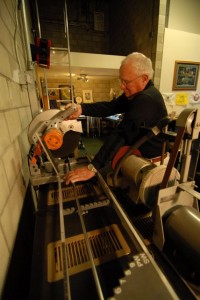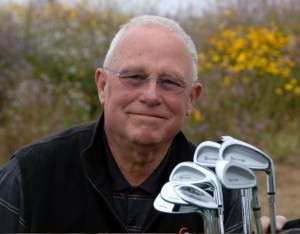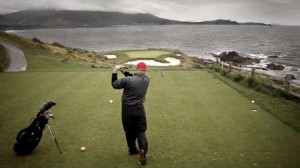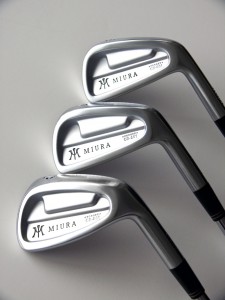An appointment with custom club fitter David Butler begins unlike any other in the world, and that’s a declarative statement without a gram of hyperbole.
After all, Butler is the only fitter with a studio in Princeton by the Sea’s Harbor Village, a mere long iron from California’s northern coast. His fittings start with a ride in a smartly restored cobalt blue 1956 Ford pickup, which sports a digitized dashboard, satellite radio and growling 6.7 Hemi under the hood. At the 3-Zero Café hard by the Half Moon Bay airport, the soft-spoken 73-year-old with rimless glasses and white hair will gently pick your brain about golf, work and life in general; assess your personality to see if you’re a compatible subject; and, buy you breakfast.
Eat the entire plate of corn beef hash and eggs, because every calorie will be burned hitting golf balls over the next three hours.
With keen observations and data collected from four separate computers, the man known as Dr. Grip can then begin to create a set of exquisite Miura irons, the heads of which are forged in Japan’s Himeji City, where master craftsmen once made legendary samurai swords. Each shaft, what Butler calls “the engine of the golf club,” must have the precise length, weight and stiffness for your individual swing, and a flex, kick-point and spine alignment that transfers maximum energy to the club-head. In turn, the shaft and club-head will produce the highest possible “smash factor measurement,” which is ball speed divided by the swing speed, while also producing a launch angle and spin rate that sends shots on a high trajectory with the proper angle of decent, so that balls drop and stop on greens.
These are only a few of the 20 or so factors that go into the custom clubs, says Butler, a former chief engineer for Chrysler Corporation, and who also ran engineering and manufacturing operations in the United Kingdom and Colombia. “What we’re trying to accomplish with the shaft and the head is his three-axis alignment process,” he explains, “which is foundational for launching missiles and golf balls alike.” Along with his engineering bent and use of technology, Butler is also a disciple of total quality improvement, and applies a systematic discipline to the club-fitting process.
Indeed, an assembled set is but a first draft. Clients are asked to hit each new club as he takes in a second set of results from a TrackMan launch monitor and a strike board, enabling Butler to make final adjustments to lie angles and lofts, and ensure that the carry between each club is roughly equal. When satisfied that the clubs are pure, only then does Butler allow them out of the studio and onto a course.
“To see people smile when they hit these clubs means everything,” he adds. “It’s my hobby and my passion.” And it certainly translates satisfied clients, including executives, professional players and even golfers who work for other club-fitting companies. Says Wayne Freedman, a San Francisco television reporter and Marin
County golfer now on his second set of Butler-crafted irons, and who has also been fitted for a driver and a putter: “Hitting a club made by David is like your first taste of chocolate.”
The Not List
The cliché is likely pre-Columbian. Golfers who hit a bad shot and blame the club are invariably informed, “It’s the Indian, buddy, not the arrow.” And to a great degree this is true. But after a session with David Butler reveals that fairly consistent swings are missing the buffalo short and wide left, it’s apparent there is something amiss in the quiver.
With off-the-shelf clubs you get what you pay for. Many sets feature shafts with miss-matched flexes and frequencies, attached to heads manufactured with relatively loose quality tolerances. It makes for a less expensive product. And according to a study sponsored by Golf magazine, 70 percent of core and avid golfers who bought clubs in the past year did not get custom fit.
The clubs might have looked and felt good, or landed on a major publication’s “hot list,” an annual ritual that sells a lot of merchandise. A little over half of the players who buy off-the-shelf clubs say they’re playing better, which suggests the other half will be back for a new set after next year’s list is published. About 20 percent of the buyers got a cursory fitting, with loft and lie angles. Only about ten percent were tested on a launch monitor, which measures spin rates, launch angle, ball speed and other factors that go into a thorough fitting. Three quarters of this group reported that they played much better than before.
Last February’s issue of Golf made a good case for fitting, contending that even a 30-minute session could yield great improvements in distance. It found that custom fit players were getting about 16 extra yards on their drives compared to their old equipment, and 20 yards with newly fitted irons. The average handicaps of the players improved from nearly 16 to slightly less than 14. It didn’t mention that participating in such a study just might motivate a golfer to practice.
The thing is, there are good fitters, mediocre fitters and people simply trying to move clubs out the door as fast as possible. A session with a master like David Butler will likely cost you $250 to $300. And a set of custom assembled Miura irons, with Butler’s private inventory of premium True Temper will cost three to four times more than premium branded clubs. That notwithstanding, a complete and thorough fitting alone was for me a much different experience than anything I’ve had in golf.
Indeed, eight years ago I had a set of Titleist irons “custom fitted” at a golf shop I won’t name, although the second half of the sign on its building rhymes with the word for abrupt flatulence. It took the guy less than ten minutes to jot down a couple numbers on lie angles, and recommend regular flex shafts. At the time I didn’t know better, but that store is definitely on my Not List. And though the clubs served me relatively well, I didn’t realize how much below their potential they performed, a fact suddenly evident while in the instructive clutches of Dr. Grip.
The Magic of Materials
A Midwestern native with four grown children and a couple of grandchildren, David Butler attended The Ohio State University, and played football for fabled Coach Woody Hayes, at least until his grade-point average began to suffer from the dual load of academics and athletics. He found his operational and supply chain work at

Butler's tool and equipment filled studio confirms that he pours nearly all of his earnings back into the club-fitting and club-making business.
Chrysler fascinating, especially when the Colombian government required that about a third of the parts in each new car had to come from local sources, which gave Butler a keen appreciation for securing quality materials. In an eclectic career he has also has worked on a nuclear reactor, flew airplanes and drove a AA Fuel National Drag Racing Champion, all of which explains his interest in engines. Before starting Butler Golf, he was an executive vice president at National Semiconductor, and started his own quality improvement process company in San Jose, for which he wrote guidebooks and processes.
“But I’ve been making and fixing clubs for more than 50 years,” he explains. “It started with my friends.” Indeed, his studio still holds a couple of his earliest tools, including a heavy brick of lead and a leather hammer, used to whack lie angles into place. He still bends them, albeit now with a special wrench and on a new Mitchel digital readout machine that reveals loft and lie angle readouts to within a one-quarter of a degree. Butler builds a couple of sets of clubs each week, and it takes hours to match the frequencies of shafts, and to locate the “spine” and get it aligned perfectly with the head, an art that demands patience, reliable tools, craftsmanship and superior raw materials.
In his early years as a club-fitter he made his own Butler Irons, custom and popular with his limited clientele. Today he’s exclusively works with the heads designed and forged by Japan’s Katsuhiro Miura and his sons. Often referred to as having “the hands of God,” Miura makes irons that are softer than most. “When the metals used by most manufacturers are molten, impurities rise up to the top, but are usually just folded back into what turns into a bar that’s used for heads,” explains Butler. “Miura takes out that top layer with the impurities, and uses only the best low-carbon premium steel.”
Because Butler’s dedication to qualify is closely aligned with Miura’s, the Japanese firm last year named him their first “featured dealer” in the U.S. Mr. Miura also recently made an in-person visit to California, and presented him with a set of irons engraved with Butler’s signature on each club.
The same conviction about quality is also applied to shafts. For irons, Butler uses only True Temper’s Tour Concept Iron Shaft, and the ultra-light M80, which the company no longer produces. “When True Temper said they weren’t going to make these, I bought their entire inventory,” says Butler, who remembers the lessons of the Colombian supply chain. “And Miura irons love these shafts.”
Engineers are not often the most outgoing personalities, which makes Butler an anomaly. At the 3-Zero, several staffers and diners come over to the table to visit. At Harbor Village, shoppers and shop-keepers alike, most of whom obviously have no interest in golf clubs, buttonhole him for brief conversations. I’m aware this is common in small towns, but in California it takes a certain character to elicit such consistent warmth from the surrounding community.
A Fitting Lesson
After breakfast we immediately started burning off the protein on Butler’s TrackMan studio, which projects images of shots downrange and provides information on ball speed, launch angle, smash factor, dispersal patterns and more. Butler’s hitting area has a soft gel pad beneath the artificial turf, to mimic real grass and ease the stress of repetitive hits. But before I start hitting Pro V’s in earnest, we try a couple of unusual clubs.
One is hooked up to a remote sonic device on the wall, which emits a tone that changes during the point where one’s wrists release. Some folks, Butler explains, release their wrists halfway down on their swing. Others never do. The tone shows mine is at the bottom of the swing, which is good, but the release is not as long as would be desired.
Another club is wired to strain gauges, to see where the club flexes on the downswing and where the droop comes into play and how much the head of the club is ahead of the shaft at impact. The wires are attached to my arm and back with Velcro straps, which makes one feel like a Dr. Frankenstein experiment. (Butler is working with a company on developing the first wireless strain gauge golf club.) During the downswing, shafts flex in two different places, first bowing at a flex point and second near the head of the club at impact. The latter is the result of centripetal force; the club-head angle flattens and it is actually ahead of the shaft, producing a measurement known as droop. This test showed I wasn’t getting much droop at impact as desired, which meant I wasn’t getting as much energy from the shaft as I should.
Butler than had me start hitting with several different shafts of different weights and stiffness, and each version with three different flexes. On the TrackMan we were comparing ball speed, face angel, vertical launch angle, the smash factor and several other pieces of data. Then we went through five different Miura heads, starting with the forged cavity-back 301model that had game improvement elements, the CB-501 with a small muscle-back component, and concluded with two conventional looking muscle-backed blades. Early on it appeared as if one of the game-improvement heads yielded acceptable distance and the highest launch angle.
From the Trackman data it’s clear that with most of the clubs, I’m getting an average smash factor of 1.4, close to the hypothetical best of 1.5. Smash factor is actually more important than club-head speed at impact. While one additional mile per hour of club-head speed will give you a yard of extra distance, one additional MPH of ball speed at impact yields 2.8 yards down the fairway. A high smash factor means you’re getting the most from the shaft and club-head.
One of the tenets of total quality management is that you go through all options, and maybe several times. So, while the Miura tour blade suggested I was getting diminishing returns, Butler still had me hit the company’s new Series 1957, which Nick Price used this March to win the Champion’s Tour Toshiba Classic. It’s about 15 percent smaller than the company’s Tour blade, but has a face with metal more dense than any other Miura model. To our surprise, the blade gave me nearly as much height as the 301, and more carry and total distance, with less dispersion on the shots.
Butler’s conclusion: I needed clubs with True Temper ultra-light M-80 shafts that are about a half-inch longer than standard, but that are nonetheless stiff. He recommended a mid-sized Iomic grip with an extra layer of wrapping under my left hand. And if the clubs performed in the real world as they did on the TrackMan, I’d be getting about 20 to 25 more yards of carry and roll from the well-fitted six iron than I did from my Titleist. Butler’s other conclusion: I should really take a couple lessons, as relatively minor adjustments to my swing would produce more consistent distance.
Tracy the Teaching Pro
That I need a little help is now obvious, since Butler now has a Miura retail showroom and club assembly site across the hallway from the shop now devoted to research and development. Not quite ready for its official grand opening, it’s the only Miura retail shop in the world. What’s more, his staff now includes Tracy Nichols, a former Sacramento State golfer who finished in the top 6 during the 2008 U.S. Women’s Amateur. She played for a time as a professional on the women’s tour in Canada, and worked as a First Tee instructor and at several golf courses in Northern California and Nevada. While she’s learning to build clubs from Butler, she also adds professional instruction to his arsenal on Fridays through Sundays.
But would a swing change obviate the entire fitting we just did?
Not at all, he says. “I make adjustments in client clubs all of the time. Swings change and lie angles need to be moved. It’s the same as when we first build a new set and go through the fine-tuning. Once we have the basics, it’s mostly little stuff. But that little stuff is important, since when one thing is wrong with the club, it has an effect on other elements.”
A good fitting, then, is also something of a major golf lesson. It’s a process that also makes one concentrate on one’s game and equipment. Moreover, when pure shots start heading long, high and straight, the formula for inducing smiles kicks in, and Dr. Grip’s passion is once again refueled.



